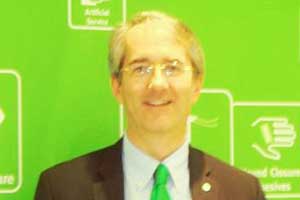 |
 |
E-News Update November 2010 |
LEAD FEATURE |
COMPANY NEWS |
MATERIALS NEWS |
MACHINERY NEWS |
EXHIBITION NEWS |
RUBBER JOURNAL ASIA |
INJECTION MOULDING ASIA |
Lead Feature
 |
BMS innovates - and looks to the East for growth
T
he recent announcement by German chemicals company Bayer MaterialScience (BMS) that it will invest EUR110 million to build five new downstream facilities in China by 2012 came as no surprise as the country has become the company's second largest market worldwide.Since China accounts for more than 40% of the company's PU business, it will build three PU systems houses in the country.
The Asia Pacific region currently accounts for more than 60% of the world's PC production, though that figure is expected to rise to 65% by 2015, with China accounting for a majority of this demand. To cater to this demand, BMS will also build a PC sheet facility and PC colour compounding and design centre in China.
The three new PU systems houses are to be built in Shanghai, Qingdao and Chongqing, with the colour compounding and design centre in Chongqing and sheet facility in Guangzhou. The company says it will then have a network covering the main areas of China as its aim is to follow the geographical expansion of the country's manufacturing centre, away from its traditional base. It also has a colour competence centre in Guangzhou and PU systems houses in Guangzhou and Nanjing.
Meanwhile, in line with its innovation streak, at the recently concluded K2010 show in Germany, the company showcased 80 new applications. The prevailing theme of sustainable solutions was applied for climate protection, technology, mobility, living and health and presented to visitors through an interactive format.
PRA spoke to the Chairman of the Board of Management of BMS, Patrick Thomas. UK-born Patrick, who has been Chairman of BMS since 2007, was formerly from US chemicals company Huntsman.
Patrick spoke about the innovations on display, the Asian market and other broader topics.
PRA: Please explain BMS's theme at the K2010.
Patrick: The theme of sustainable solutions relates to the demographic shifts taking place in many societies, global climate change and the increasing shortages of resources. At the same time, we are focusing on exploring new business opportunities by fulfilling future needs. We are known around the world as "The Inventor Company" and K2010 is the perfect environment in which to position ourselves as a technology leader.
PRA: Since many of the exhibits are futuristic, will the materials expect to be commercialised?
Patrick: The exhibits provide specific examples of new applications. Almost 40% of the materials BMS sells today were not in existence five years ago. Nearly 80% of our business is supplying valuable commodities, where there are no switching costs involved for customers, and the other 20% consists of differentiated materials. Technology is something that needs to keep on going and we will continue to innovate.
PRA:Is any R&D for cutting edge innovations being done in Asia?
Patrick: Our integrated site in Shanghai, China, will be a key centre for R&D (the total investment planned by the Bayer Group for this site amounts to EUR2.1 billion, with EUR0.7 billion from 2009 until 2012).
Already, 60% of the PC market is in Asia, compared to 15% in the US. So this is of huge significance and we plan to grow the R&D work we are doing in Shanghai significantly over the next three years, especially for the automotive market.
In Singapore, we recently set up a Functional Films R&D facility - we will look at expanding this. The centre, which is our first outside of Germany, represents an initial investment of EUR7 million with a further provision for broadening capabilities in subsequent years.
The challenge for us right now is how to transfer the knowledge from Europe to Asia. We are looking at human resource movement, for instance senior managers, and will move the knowledge to where it needs to be now
We definitely have to increase our resources significantly in China for the electronics and automotive sectors, with the Functional Film centre in Singapore to tie in with this.
PRA: Explain the R&D undertaken at the Functional Films Centre in Singapore.
Patrick: We are focusing on leading edge coated high-tech films and nanotechnology to meet the growing demand for electronic films in Asia, especially in Japan, South Korea and Taiwan.
Using self-developed material technologies, we will pursue joint projects with collaboration partners to create breakthroughs in electronics, like functional films that can be applied to flexible screens and three-dimensional displays as well as nanomaterials like conductive inks used in printed electronics or energy-efficient lighting technologies.
PRA: What are the innovations in the PC market?
Patrick: Our Makrolon PC offers clear advantages over glass in the field of automotive glazing. As the plastic weighs up to 50% less than traditional glazing, it leads to a considerable reduction in fuel consumption.
In fact, over the next few months, the level of adoption of PC glazing will be higher with more car manufacturers switching to it. There are more than 25 car models in the pipeline, even high-end ones like the Bugatti (in the transparent panorama roof of the new Bugatti Veyron 16.4 Grand Sport luxury coupé) and Porsche (in a 100% off-the-road demonstration model).
Early this year, we tied up with Mitsubishi Heavy Industries Plastic Technology and Kyowa Industrial to combine their expertise in injection moulding applications to drive forward technological developments for this range of applications and the use of PC glazing in the Japanese automotive industry.
The next phase will be the tailgate concept. We are presenting at the K a prototype concept in a complete, one-piece tailgate with windshield. Unlike conventional models with a metal support and pane of glass, this highly integrated component features a completely joint-free outer shell made of PC.
PRA:A carbon nanotube (CNT) pilot plant has been set up by BMS, how far is the company into this compared to the competition?
Patrick: Our Baytube CNT pilot plant is running in Leverkusen, Germany. CNTs are at least 20 years away from actual applications. But we are conducting trials and sampling with various sectors.
For instance CNTs can be used to manufacture wind turbine rotor blades. Their length was previously limited to around 60 m as larger blades did not have the required strength. Nanotubes impart a high degree of stiffness to the rotor blades and are also very lightweight, meaning that the rotors can be constructed on a larger scale and provide a more efficient means of power generation.
Another area is in ship paint. The problem in the shipping industry is the highly toxic chemical used to stop the fouling on hull bottoms as this may find its way into the sea. A solution is using CNT-based paints and coatings that reduce fuel usage in a ship by 17%, compared to a fouled ship.
The next stage of innovation for CNTs is molecular composites (nanocomposites) where size reduction introduces unique properties into the materials.
PRA:What other innovations can we expect from BMS in the future?
Patrick:One of our current areas of interest is catalysis - in the polymerisation of carbon dioxide. We are working together with the University of Aachen, RWE Power and Siemens and looking at building a pilot plant for this.
|
B ayer recently issued a statement to say it is cooperating with ten partners from universities and the scientific world to research new methods of utilising carbon dioxide using renewable energies. With a share of over EUR3 million, Bayer's technology subsidiary (BTS) is the biggest investor in the CO2RRECT (CO2-Reaction using Regenerative Energies and Catalytic Technologies) initiative. BTS is managing the EUR18 million research project, which is receiving EUR11 million in grants over three years from the German Federal Ministry of Education and Research (BMBF).The technology aims to apply this energy for utilising CO2 as carbon building block for chemical intermediates such as carbon monoxide or formic acid. This also creates opportunities to incorporate the climate gas CO2 in, for instance, plastics. Therefore CO2 can be used as a raw material for products and household items or for CDs. For this purpose new models of interaction between the energy and chemical industries are being developed. The CO2 used in the project comes from RWE Power's lignite power plant in Niederaussem, Germany. At its Coal Innovation Centre there, the company operates a CO2 scrubber where the carbon dioxide is separated from the flue gases and a liquefaction facility that enables further CO2 transportation. In the CO2RRECT project, RWE is jointly responsible for the development of dynamic electrolysis processes that are supposed to ensure an intelligent and economically efficient use of energy by taking advantage of energy fluctuations or energy surpluses in the power network. The objective is to assess scaling of the entire process to demonstration scale (MW plant) and to initiate this process. Siemens is contributing its expertise in the field of water electrolysis, which is essential for smoothing out fluctuations in the power network and enabling the utilisation of overcapacities, thereby allowing for cost-effective hydrogen production via electrolysis. Further optimisations for higher efficiency and higher operating temperatures are also planned. A 100 kW modular construction unit is being built with respect to testing its suitability as dynamic network component within the project. |
